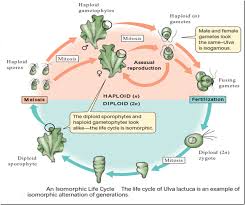Algae vary in size, ranging from small, microscopic, unicellular forms like Chlamydomonas to large, macroscopic, multicellular forms like Polysiphonia. The multicellular forms exhibit great diversity in their organization and include filamentous, heterotrichous, thalloid, and polysiphonous types.
This article will explore the types of reproduction and the life cycle in algae, using suitable representative examples from various groups. Algae demonstrate all three types of reproduction: vegetative, asexual, and sexual.
Vegetative reproduction relies solely on the ability of fragments of algae, which are accidentally broken, to produce new individuals through simple cell division.
Asexual reproduction, on the other hand, involves the production of new cells, known as zoospores.
In sexual reproduction, gametes are produced. These gametes fuse in pairs to form a zygote. The zygote may divide and develop into a new thallus, or it may secrete a thick wall to form a zygospore. Sexual reproduction in algae features many interesting processes, which will be examined in detail.
Types of Reproduction in Algae
The reproductive processes found in various groups of algae can be broadly divided into three main types: vegetative, asexual, and sexual reproduction.
A. Vegetative Reproduction
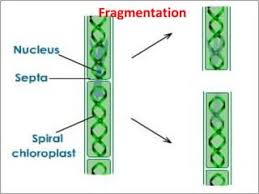
The most common form of reproduction in algae is binary fission. In unicellular, prokaryotic algae like Anacystis, this is the only method of reproduction found in nature. In filamentous and multicellular forms, algae may be accidentally broken into small pieces, with each piece developing into a new individual. These methods of propagation are collectively known as vegetative reproduction.
B. Asexual Reproduction
Asexual reproduction in algae occurs when vegetative reproduction takes place through specialized cells, other than sex cells. Below are examples of asexual reproduction in different algae:
1. Anabaena and Nostoc: In these algae, cells accumulate food materials and develop thick walls to become spores or akinetes. Akinetes can withstand dryness (lack of water) and high temperatures for extended periods. However, when conditions are suitable, they germinate and form new filaments.
2. Ulothrix: Filamentous algae such as Ulothrix reproduce by producing motile cells called zoospores. The protoplast of a single cell divides multiple times via mitosis to produce several zoospores, which then settle by their anterior end.
The zoospore divides into two cells: the lower cell forms the holdfast, while the upper cell divides further to become the vegetative filament. Zoospores are also produced in other algae.
3. Chlamydomonas: Although Chlamydomonas is a unicellular, motile algae, it also produces zoospores. The parent cell divides inside its envelope, and each daughter cell develops two flagella. These zoospores resemble the parent cell but are smaller in size. Once fully developed, the parent cell wall dissolves, releasing the zoospores into the surrounding water.
In dry conditions, zoospores may lose their flagella and round up to form aplanospores, which develop into thick-walled hypnospores. When zoospores cannot be released due to lack of water, they become embedded within a gelatinous material formed from the parent cell wall. These non-motile cells are known as the palmella stage of Chlamydomonas.
4. Oedogonium Zoospores: Oedogonium produces zoospores singly within a cell. Each zoospore has one nucleus and a crown of flagella at its apex. Many zoospores are produced from a single cell, as seen in Ulothrix, with each zoospore containing a single nucleus and 2-4 flagella.
5. Ectocarpus Zoospores: Zoospores in Ectocarpus are produced in sporangia, which can be of two types:
i. Plurilocular Sporangia: These sporangia consist of many cells, and several biflagellate zoospores are produced.
ii. Unilocular Sporangia: These sporangia consist of a single cell that produces a single biflagellate zoospore.
Read Also: Concrete Pond Management: Steps to take before introducing the Fish in the Water
C. Sexual Reproduction in Algae
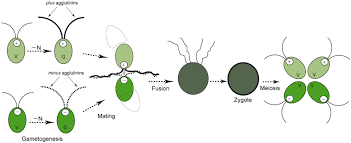
Sexual reproduction in algae, as in other organisms, involves the fusion of two gametes (cells from opposite sexes), resulting in the formation of a zygote. The following are some basic features of this reproductive method:
i. Gametes are always haploid and may or may not differ in morphology.
ii. If both gametes appear alike, they are referred to as male (+) or female (-) mating types. Gametes can fuse only when one is plus (+) and the other is minus (-).
iii. Both the plus and minus gametes may be produced by a single parent. This is known as the monoecious or homothallic condition.
iv. When the gametes come from different plus or minus thallus types, it is called the dioecious or heterothallic condition.
Types of Gametic Fusion
There are three types of gametic fusion:
1. Isogamy: This occurs when both gametes are of the same size and morphology.
2. Anisogamy: In this type, the two gametes are distinctly different in size or shape. The larger of the two is the minus (female) type.
3. Oogamy: The female gamete (egg or ovum) is large in size and non-motile, lacking flagella. The male gametes are flagellated and highly motile. These male gametes are also known as antherozoids, spermatozoids, or sperms.
Male gametes are attracted to the female gametes due to special hormones called gamones (volatile hydrocarbons) produced by the female cells. Fusion of the gametes results in the formation of a zygote.
If conditions are unfavorable for growth, the zygote may develop a thick wall and become a resting zygospore.
Gametes, being haploid, are produced by mitosis in a haploid thallus. If the thallus is diploid (as in Fucus), the reproductive cells undergo meiosis (reduction division) to form haploid gametes.
In a haploid thallus, after gamete fusion, the diploid zygote undergoes meiosis during germination. In contrast, in diploid algae, the zygote may divide mitotically to give rise to a diploid thallus (as seen in Fucus). Both haploid and diploid thalli are found in Ulva, and they look very similar in size and shape.
Reproduction and Life Cycle in Algae
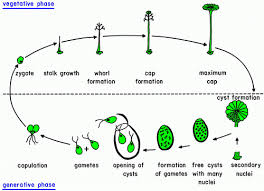
The basic modes of reproduction in algae have been discussed above. Now, specific algal types will be examined to illustrate their life cycles in nature.
It is important to note that the life cycle of algae is strongly influenced by environmental factors, such as temperature, light, seasons, nutrient availability, salinity, wave action, and the periodicity of tides in the case of marine forms.
Observations made by researchers at different times, from various geographical locations, and under controlled conditions, provide a fairly comprehensive—if not complete—understanding of the life cycle of algae.
A. Reproduction and Life Cycle in Chlamydomonas
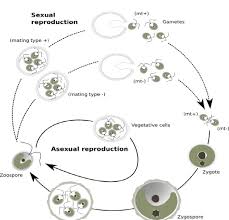
Sexual reproduction in Chlamydomonas demonstrates all three different types of gametic fusion, depending on the species. Isogamy is found in C. reinhardii, C. gynogama, and C. media.
Isogamy can be divided into two types:
- In clonal populations (cells obtained by the repeated division of a single parent cell), fusion may occur between gametes that are homothallic or in self-compatible strains. For example, fusion takes place between any two cells of C. gynogama and C. media.
- In C. moewusii and C. reinhardii, fusion of gametes occurs only when they come from two different, unrelated (heterothallic, self-incompatible) strains.
In many isogamous species, the parent cell may divide to produce 16 to 64 biflagellate gametes. In some cases, the adult cells themselves may directly behave as gametes and fuse.
An anisogamous form of gametic fusion is found in C. braunii. In this species, the female cell divides to produce four larger cells, each with two flagella but less active. The male cells are about 8 in number and smaller in size.
Oogamy is the advanced form of sexual reproduction observed in C. coccifera. In this species, the parent cell discards its flagella and directly becomes a non-motile egg or ovum. Meanwhile, the male parent cell undergoes repeated divisions to produce sixteen male gametes, which are biflagellate and highly motile.
The process of gametic attraction, fusion, and related phenomena has been studied in detail in the laboratory. Under appropriate light conditions and carbon dioxide concentration, gamete production can be initiated by nitrogen starvation.
The formation of male or female gametes (even in the case of isogamy) is attributed to the varying concentration of gamones produced by the cells.
The attraction between gametes occurs due to the presence of glycosidic mannose at the tips of the flagella of one strain, which binds in a complementary way with the substance present in the flagella of the gametes of the opposite strain.
Once the flagella of the plus and minus gametes stick together, they twist around each other, bringing the anterior ends of the gametes closer. This is followed by cellular and nuclear fusion.
The zygote secretes a thick wall and accumulates a large amount of food materials, such as starch, lipids, and orange-red pigments.
It is now known as a zygospore, which remains dormant until environmental conditions become favorable for its germination. During germination, meiosis takes place, followed by mitosis, resulting in haploid Chlamydomonas cells.
Chlamydomonas is unicellular, haploid, and reproduces asexually multiple times by forming zoospores. Under unfavorable environmental conditions, it produces gametes, which fuse to form a diploid zygospore.
During germination, reduction division takes place, resulting in the formation of haploid cells.
Significance of Chlamydomonas in Biological Research
Chlamydomonas is of great interest to biologists due to the following interesting features of biological importance:
- Presence of DNA in the chloroplasts of the alga.
- Presence of cytoplasmic genes.
- Production of genetic mutations affecting nutrition, photosynthesis, and the formation of mutants without flagella or cell walls.
- Discovery of gamones and their role in sexual reproduction.
- Presence of isogamy, anisogamy, and oogamy within a single genus.
- Control of reproduction by environmental conditions.
Alternation of Generations Life Cycle
The type of life cycle in which reproduction alternates between sexual and asexual methods with each generation is called the alternation of generations. The two generations are termed the gametophytic and sporophytic generations. The gametophytic generation is haploid (n), while the sporophytic generation is diploid (2n).
The fusion of two haploid gametes (n) results in a diploid zygote (2n), which, upon germination, forms the plant or thallus known as the sporophyte. The sporophyte, in turn, produces haploid spores through meiosis. When a spore germinates, it develops into a gametophyte, which bears male or female gametes, or both, on the same plant or thallus.
In some bryophytes, the gametophytic generation is more conspicuous, while in ferns, the sporophytic generation is more prominent. In angiosperms, the main plant body is the sporophyte, and the gametophytic generation is reduced to just a few cells. All types of these conditions can be observed in algae as well. In some algae, the gametophyte is more prominent, while in others, the sporophyte is more prominent.
A. Reproduction and Life Cycle in Ulothrix
Sexual reproduction in Ulothrix occurs through isogamous biflagellate gametes. Fusion takes place only between plus and minus mating types, with the gametes coming from different filaments (heterothallic). The resulting zygote develops a thick wall and remains dormant until favorable conditions for germination arise. When conditions become favorable, meiosis occurs, producing 4–16 haploid zoospores that settle and give rise to vegetative filaments.
It has been observed that Ulothrix produces gametes under long-day conditions, while short-day conditions initiate the formation of zoospores.
The thallus of Ulothrix is haploid, and the diploid stage is represented solely by the zygote. Notably, in some species (U. speciosa, U. flacca, and U. implexa), the zygote develops into an independent, unicellular, diploid thallus. This thallus produces zoospores asexually by meiosis. The zoospores then develop into haploid filaments.
Thus, two types of life cycles can be distinguished in Ulothrix:
1. Haplobiontic: The thallus is haploid, and only the zygote is diploid (e.g., U. zonata).
2. Diplobiontic: In the diplobiontic cycle, the alga consists of a haploid thallus that produces gametes and a diploid unicellular stalked thallus that produces zoospores after meiotic division. The two generations—haploid and diploid—alternate with each other (alternation of generations). Since the two thalli differ significantly in size and morphology, this life cycle is known as a heteromorphic, diplobiontic life cycle.
Read Also: Importance of a Fish Net on a Concrete Pond
B. Reproduction and Life Cycle in Fucus
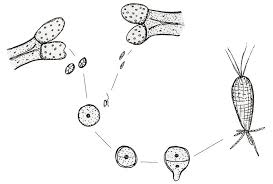
Fucus has an advanced type of reproductive structure, termed receptacles, which are swollen at the tips of branches. Distributed across the surface of each receptacle are small pores, known as ostioles, which lead into cavities called conceptacles.
Each conceptacle may produce either eggs, sperms, or, in some cases, both. A thallus may be unisexual, containing either male or female receptacles only.
At the base of the conceptacle is a fertile layer of cells that develops into oogonia. Each oogonium consists of a basal stalk cell and an upper cell, which undergoes reduction division to produce eight haploid eggs.
These eggs are liberated within the conceptacle. Some of the cells inside the conceptacle produce unbranched multicellular hairs called paraphyses, which emerge from the ostiole as tufts.
Antheridia are produced on branched paraphyses within the conceptacle. Each antheridium functions like a unicellular sporangium, dividing meiotically and then through further divisions to produce 64 haploid sperms.
The biflagellate sperm has a longer flagellum pointing backward and a shorter one projecting forward. It contains a single chloroplast and a prominent orange eyespot.
The release of gametes is synchronized with sea tides. At low tide, Fucus fronds shrink due to water loss, and when exposed to an incoming tide, the eggs and sperms are released into the surrounding seawater.
The eggs of Fucus are known to attract sperms by secreting a gamone. Immediately after fertilization, a cell wall is secreted around the zygote. It has been shown that unfertilized eggs can develop into germlings parthenogenetically when treated with dilute acetic acid.
The diploid zygote germinates by producing a rhizoidal outgrowth on one side. It is later divided by wall formation to form a lower rhizoidal cell and an apical cell, which, through further divisions, gives rise to the Fucus fronds.
In conclusion, Reproduction in algae can occur through vegetative methods (such as binary fission), asexual reproduction via specialized cells, or sexual reproduction through the fusion of two gametes from opposite sexes.
The life cycles of Chlamydomonas, Ulothrix, and Fucus were discussed, and it should be noted that algae also exhibit alternation of generations in their life cycles.
Do you have any questions, suggestions, or contributions? If so, please feel free to use the comment box below to share your thoughts. We also encourage you to kindly share this information with others who might benefit from it. Since we can’t reach everyone at once, we truly appreciate your help in spreading the word. Thank you so much for your support and for sharing!
Read Also: Causes and Effects of Deforestation

